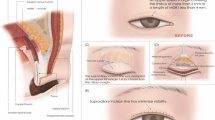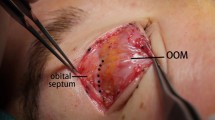Abstract
Background
The double-eyelid operation is the most requested cosmetic surgery in Asians. The incision is usually located at the pretarsal skin 6 mm to 8 mm above palpebral margin. The purpose of this paper is to report a novel approach of double-eyelid operation through a supraciliary incision (SCI).
Methods
Three transverse curved lines were drawn on the upper lid skin. The location of line 1 (SCI) was 1.5 mm above the eyelash, line 2 according to the amount of redundant skin excised and line 3 at 3 mm to 4 mm above line 2. After the incisions were made between line 1 and line 2, the subcutaneous dissection is carried out over 5 mm the line 3. Then, the redundant skin and a strip orbicularis oculi muscle were removed to open the orbital septum and to explore underside levator aponeurosis. Along the line 3, the internal buried fixation sutures between dermal tissue and the fusion line of the orbital septum and levator aponeurosis were placed. Finally, the wounds were closed between line 2 and line 1.
Results
There were 528 patients who underwent the double-eyelid operation through the supraciliary approach. In long-term follow-up, 288 patients were evaluated at 6 months to 78 months postoperatively. Of those, 266 patients were satisfactory for the result (92.36%) with natural shape and invisible surgical scar. In another 22 patients (7.63%), a revised blepharoplasty was performed in 22 eyelids.
Conclusion
The double-eyelid surgery using the SCI has several advantages including less visibility of the incision, the protected subdermal vascular network, the intact continuity of the upper eyelid skin, the combination of the SCI and internal dermal buried suture method. The approach can be considered an efficient technique for Asian patients.
Level of Evidence IV
This journal requires that authors assign a level of evidence to each article. For a full description of these Evidence-Based Medicine ratings, please refer to the Table of Contents or the online Instructions to Authors www.springer.com/00266.












Similar content being viewed by others
References
Sayoc BT (1956) Absence of superior palpebral fold in the slit eyes: an anatomic and physiologic explanation. Am J Ophthalmol 42(2):298–300
Liu D, Hsu WM (1986) Oriental eyelids: anatomic difference and surgical consideration. Ophthalmic Plast Reconstr Surg 2(2):59–64
Xu FZ, Zeng W, Fan GK, Chen J, Li H (2009) Double eyelid operation recreating the anatomic microstructure. Ann Plast Surg 63(3):242–248
Lee CK, Ahn ST, Kim N (2013) Asian upper lid blepharoplasty surgery. Clin Plast Surg 40(1):167–178
Oh YW, Seul CH, Yoo WM (2007) Medial epicanthoplasty using the skin redraping method. Plast Reconstr Surg 119(2):703–710
McCurdy JA (2002) Cosmetic surgery of the Asian Face. In: Papel ID (ed) Facial plastic and reconstructive surgery, 2nd edn. Theime Medical Publisher, New York, pp 322–343
Hwang K, Kim DJ, Hwang SH (2006) Thickness of Korean upper eyelid skin at different levels. J Craniofac Surg 17(1):154–156
Lee Y, Hwang K (2002) Skin thickness of Korean adults. Surg Radiol Anat 24(3–4):183–189
Kakizaki H, Takahashi Y, Nakano T, Ikeda H, Selva D, Leibovitch I (2011) The distribution of elastic fibers in the Asian upper eyelid skin. Ophthalmic Plast Reconstr Surg 27(3):201–203
Ince B, Dadaci M, Oltulu P, Altuntas Z, Bilgen F (2015) Effect of dermal thickness on scars in women with type III–IV Fitzpatrick skin. Aesthetic Plast Surg 39(3):318–324
Kao YS, Lin CH, Fang RH (1998) Epicanthoplasty with modified Y–V advancement procedure. Plast Reconstr Surg 102(6):1835–1841
Lee YJ, Baek RM, Song YT, Chung WJ, Lee JH (2006) Periciliary Y–V epicanthoplasty. Ann Plast Surg 56(3):274–278
Chen W, Li SK, Li YQ, Wang YN (2009) Medial epicanthoplasty using the palpebral margin incision method. J Plast Reconstr Aesthet Surg 62(12):1621–1626
Seo JD, Kim JH, Pak CS, Heo CY (2014) Medial epicanthoplasty using the “inside-out” technique. J Plast Surg Hand Surg 48(2):139–142
Imanishi N, Kishi K, Chang H, Nakajima H, Aiso S (2008) Three-dimensional venous anatomy of the dermis observed using stereography. J Anat 212(5):669–673
Hao P, Zhang H, Shang Y, Wang SM (2001) The double-eyelid surgery using the method of palpebral margin incision combined with subcutaneous buried suture fixation (6 cases report). Chin J Med Aesthet Cosmet 7(5):275
Deng GP, Lin Q, Zhou JL, Lou YJ (2007) The double-eyelid blepharoplasty using palpebral edge incision. Chin J Aesthet Plast Surg 18(6):465–466
Zhang H, Hao P, Xu K (2008) Construction of double eyelid with incision of palpebral margin. Chin J Med Aesthet Cosmet 14(2):101–103
Zhu ZK, Qi XF (2012) The double-eyelid surgery using the peri-palpebral margin incision: clinical application. Chin J Aesthet Med 21(2):224–225
Xu B, Cao SJ, Zhu ZY, Yu J (2013) Construction of double eyelid with incision of upper palpebral margin for the patients with upper eyelid skin laxity. Chin J Aesthet Med 22(1):5–7
Fang S, Zhu W, Xing X, Yang C (2018) Double eyelid surgery by using palpebral marginal incision technique in Asians. J Plast Reconstr Aesthet Surg 71(10):1481–1486
Choi Y, Kang H-G, Nam Y-S (2017) Three skin zones in the Asian upper eyelid pertaining to the Asian blepharoplasty. J Crianofac Surg 28(4):892–897
Choi Y, Eo S (2016) Outer fascia of orbicularis oculi muscle as an anchoring target tissue in double eyelid surgery. J Craniofac Surg 27(2):322–327
Czyz CN, Hill RH, Foster JA (2013) Preoperative evaluation of the brow-lid continuum. Clin Plast Surg 40(1):43–53
Lam VB, Czyz CN, Wulc AE (2013) The brow-eyelid continuum an anatomic perspective. Clin Plast Surg 40(1):1–19
Kim YS, Roh TS, Yoo WM, Tark K-C, Kim JY (2008) Infrabrow excision blepharoplasty: applications and outcomes in upper blepharoplasty in Asian women. Plast Reconstr Surg 122(4):1199–1205
Lee D, Law W (2009) Subbrow blepharoplasty for upper eyelid rejuvenation in Asians. Aesthet Surg J 29(4):284–288
Sugamata A, Yoshizawa N (2010) Infraeyebrow excision blepharoplasty for Japanese blepharochalasis: review of 35 patients over 60 years old. J Plast Surg Hand Surg 44(1):17–20
Fang Y-H, Liao W-C, Ma H (2013) Infraeyebrow blepharoplasty incorporated browpexy in an Asian population. Ann Plast Surg 71(suppl1):S20–S24
Yuzuriha S, Matsuo K, Kushima H (2000) An anatomical structure which results in puffiness of the upper eyelid and a narrow palpebral fissure in the Mongoloid eye. Br J Plast Surg 53(6):466–472
Haramoto U, Kubo T, Tamatani M, Hosokawa MK (2001) Anatomic study of the insertions of the levator aponeurosis and Muller’s muscle in oriental eyelids. Ann Plast Surg 47(5):528–533
Kakizaki H, Zako M, Nakano T, Asamoto K, Miyaishi O, Iwaki M (2005) The levator aponeurosis consists of two layers that include smooth muscle. Ophthal Plast Reconstr Surg 21(5):379–382
Kakizaki H, Leibovitch I, Selva D, Asamoto K, Nakano T (2009) Orbital septum attachment on the levator aponeurosis in Asians: in vivo and cadaver study. Ophthalmology 116(10):2031–2035
Kakizaki H, Selva D, Asamoto K, Nakano T, Leibovitch I (2010) Orbital septum attachment sites on the levator aponeurosis in Asians and whites. Ophthalmic Plast Reconstr Surg 26(4):265–268
Doxanas MT, Anderson RL (1984) Oriental eyelids: an anatomic study. Arch Ophthalmol 102(8):1232–1235
Jeong S, Lemke BN, Dortzbach RK, Park YG, Kang HK (1999) The Asian Upper Eyelid: the Asian upper eyelid: an anatomical study with comparison to the Caucasian eyelid. Arch Ophthalmol 117(7):907–912
McCurdy JA (2005) Upper blepharoplasty in the Asian patient: the “double eyelid” operation. Facial Plast Surg Clin North Am 13(1):47–64
Kim HS, Hwang K, Kim CK, Kim KK (2013) Double-eyelid surgery using septoaponeurosis junctional thickening results in dynamic fold in Asians. Plast Reconstr Surg Glob Open 1(2):1–9
Funding
There is no financial disclosure to claim, and the research has no funds sponsored.
Author information
Authors and Affiliations
Corresponding author
Ethics declarations
Conflict of interest
The authors declare that they have no conflicts of interest to disclose.
Research Involving Human and Animal Rights
This article does not contain any studies with human participants or animals performed by any of the authors.
Informed Consent
For this type of study informed consent is not required.
Additional information
Publisher's Note
Springer Nature remains neutral with regard to jurisdictional claims in published maps and institutional affiliations.
Electronic supplementary material
Below is the link to the electronic supplementary material.
Supplementary file1 (MP4 164225 kb)
Supplementary file2 (MP4 2074 kb)
Supplementary file3 (MP4 1495 kb)
Supplementary file4 (MP4 3496 kb)
Supplementary file5 (MP4 1321 kb)
Supplementary file6 (MP4 5771 kb)
Supplementary file7 (MP4 7963 kb)
Supplementary file8 (MP4 1885 kb)
Rights and permissions
About this article
Cite this article
Ouyang, LP., Cheng, NX. Supraciliary Incision as a New Double-Eyelid Approach for Asian Patients: Clinical Experience of 528 Cases. Aesth Plast Surg 44, 1560–1574 (2020). https://doi.org/10.1007/s00266-020-01838-4
Received:
Accepted:
Published:
Issue Date:
DOI: https://doi.org/10.1007/s00266-020-01838-4




